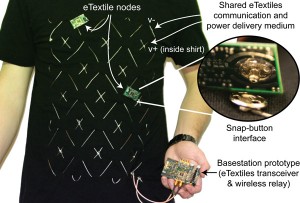An Energy-efficient eTextiles Transceiver for Body-area Networks
Advances in sensor technologies are creating a paradigm shift in the way humans interact with their environments. For instance, one does not have to look too far to see the impact an accelerometer sensor in the Nintendo Wii-mote has had on video games or a capacitive touch-screen sensor in the iPhone has had on mobile devices. While both of these devices use ICs for wireless communications, they share a common attribute: their physical sizes are large enough to accommodate batteries of reasonable capacity. Since the human body is a very complex and mostly analog system, the field of medical monitoring electronics should be able to leverage emerging sensor technologies to improve health care and quality of life in a dramatic way. Unfortunately, size restrictions (due to either aesthetics or biology) require sensor nodes and, as a result their energy storage elements, to be physically small. Such nodes are often communication-power-dominated, making the design of long-battery-life sensor nodes challenging without a reduction in communication power.
To address this problem for body-worn sensor nodes, we propose the use of electronic textiles as a communication medium. Figure 1 shows the implemented eTextiles system [1]. The so-called “network-on-shirt” is comprised of a two-wire conductive yarn medium, transceiver ICs, and a basestation IC used for data collection and medium-access administration. The transceiver ICs (Figure 2) use supply-rail-coupled differential signaling to time-share the medium between communication and remote charging circuits. During remote charging, the basestation’s battery is connected to the super-capacitor power supplies of the transceiver ICs via the network and remote charging transistors, achieving greater than 95% power transfer efficiency. Designed in 0.18μm CMOS and operating at 0.9V, the transceiver consumes 110μW at a data rate of 10Mbps (including baseband power). The transmitter and receiver front-ends together consume 3.2pJ/bit over 1m, which is 20-100X more efficient than comparable wireless and body-coupled communication approaches [2] [3], thereby enabling long-battery-life, body-worn sensor nodes.
References
- P. P. Mercier and A. P. Chandrakasan, “A 110μW 10Mb/s eTextiles Transceiver for Body Area Networks with Remote Battery Power,” IEEE ISSCC Dig. Tech. Papers, pp. 496-497, Feb. 2010. [↩]
- M. Verhelst, N. Van Helleputte, G. Gielen, and W. Dehaene, “A reconfigurable, 0.13µm CMOS 110pJ/pulse, fully integrated IR-UWB receiver for communication and sub-cm ranging,” ISSCC Dig. Tech. Papers, pp. 250-251, Feb. 2009. [↩]
- N. Cho, J. Bae, S. Kim, and H.-J. Yoo, “A 10.8mW body-channel-communication/MICS dual-band transceiver for a unified body-sensor-network controller,” ISSCC Dig. Tech. Papers, pp.424-425, Feb. 2009. [↩]

